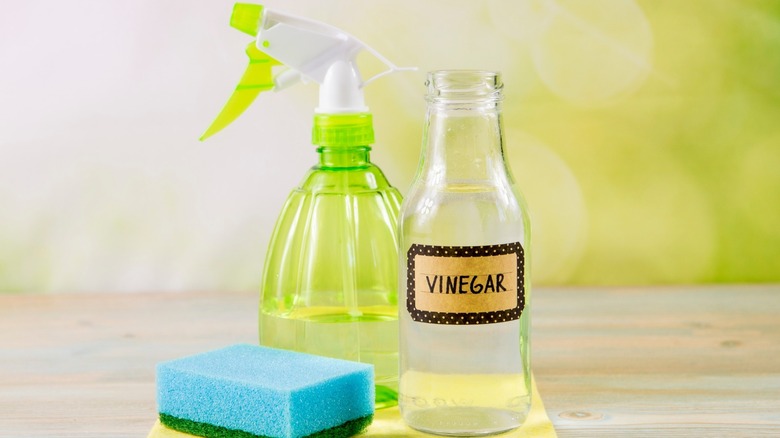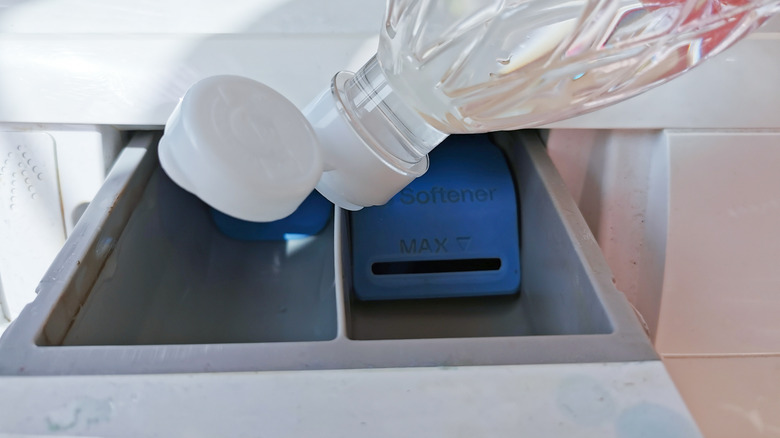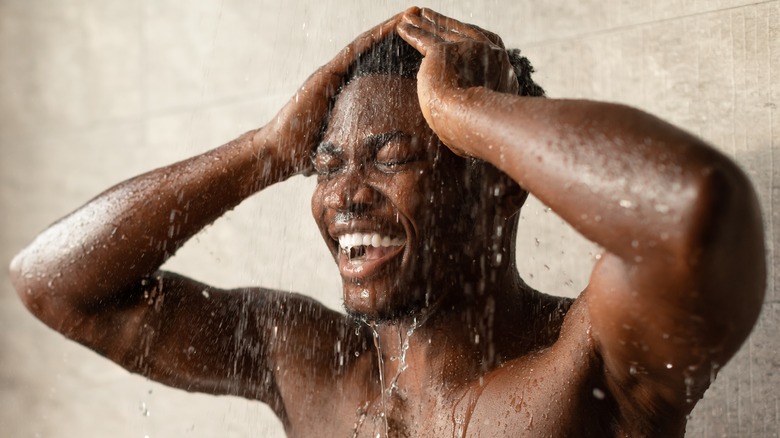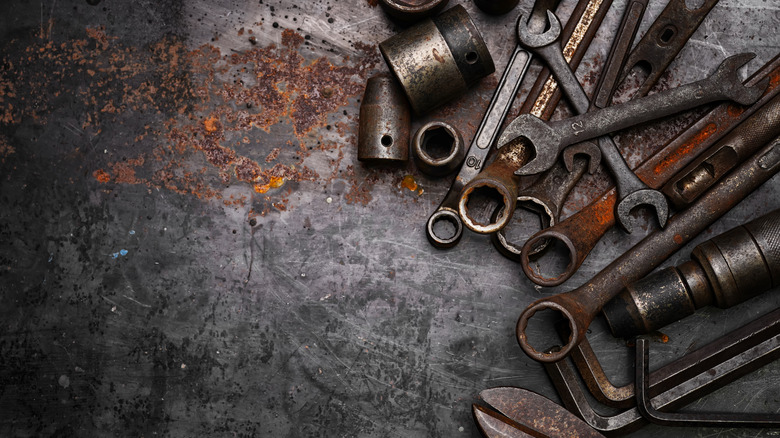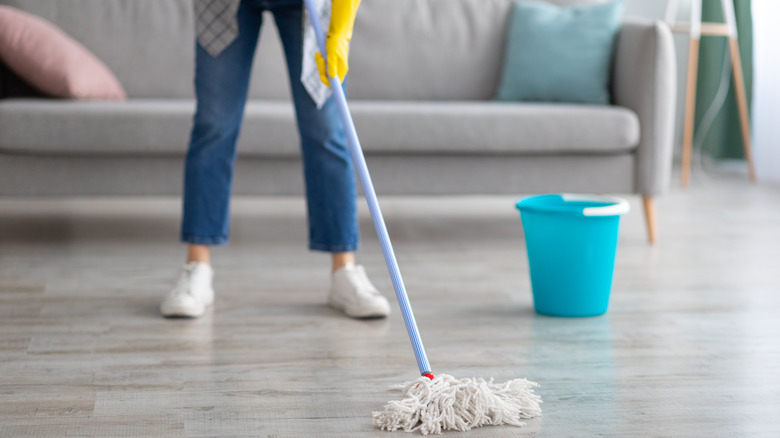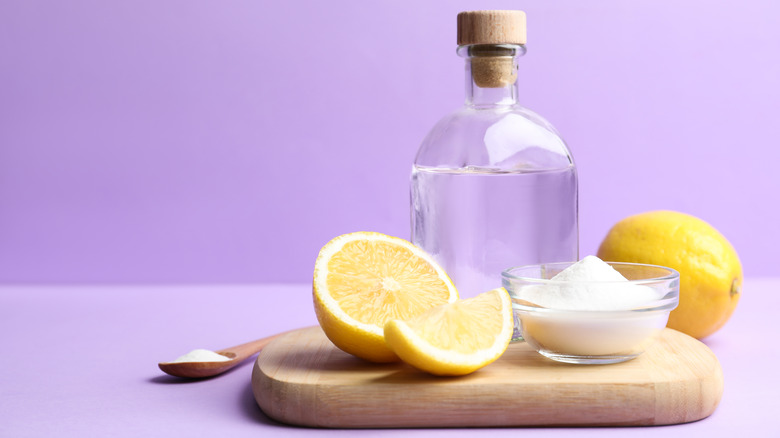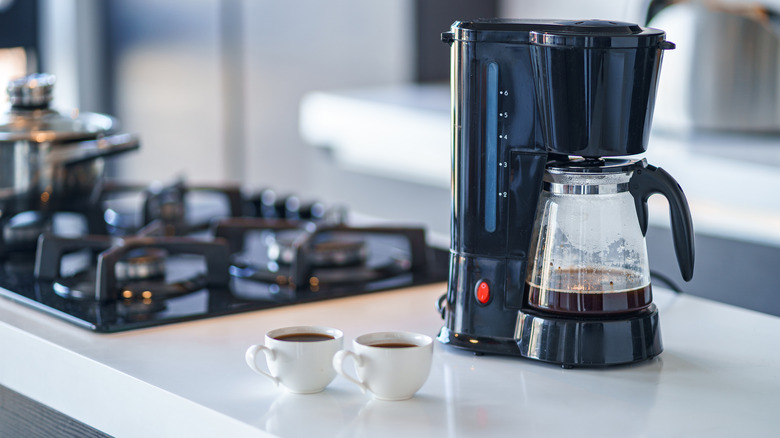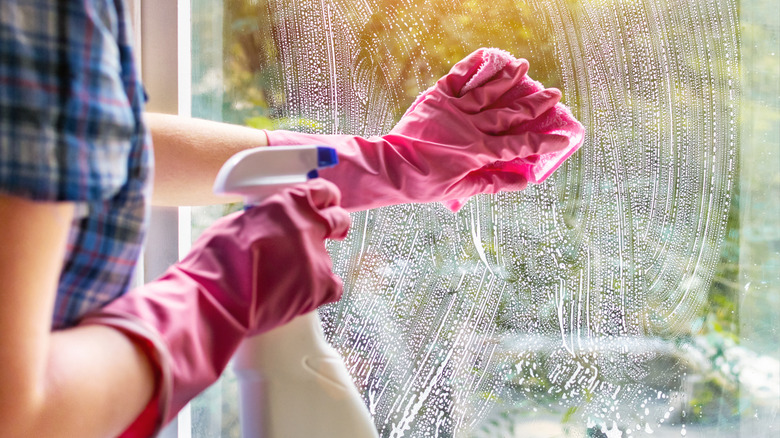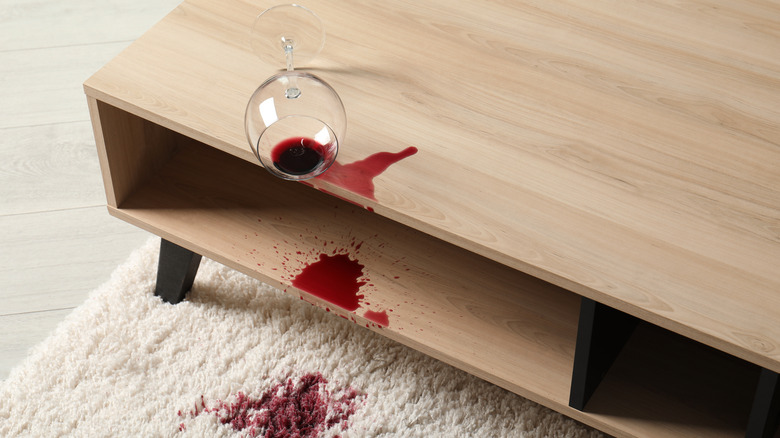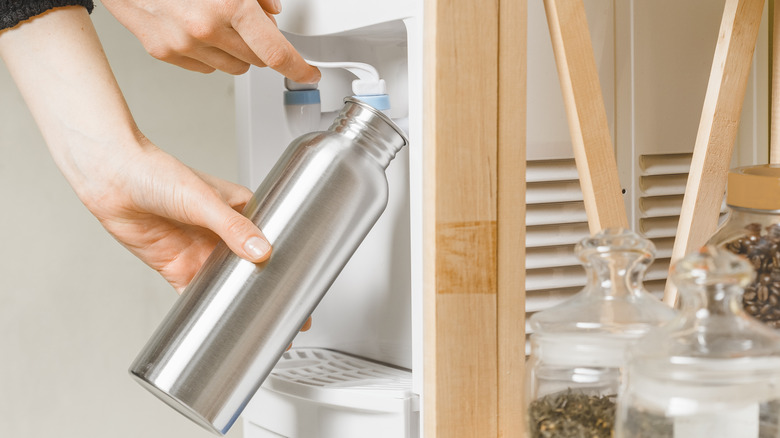How Vinegar Can Be A Versatile Cleaning Tool
Vinegar is one of those amazing household products you can use for all sorts of cleaning jobs. It has the power to make it easier to lift up stains and soap scum, and it makes it easy to clean water bottles and coffee makers. It's the acidic nature of vinegar that makes it such an amazing tool; it removes build-up and helps add shine. Removing grime in things like coffee makers helps them run more efficiently.
Vinegar makes cleaning time shorter at times and can cut down on how much scrubbing you have to do. However, it's that hands-on time that is really nixed by using this powerful liquid. To remove things like soap scum and stinky odors set into showerheads and plastic containers, you just need to soak the item in vinegar for a set amount of time, and voilà!
Sometimes your vinegar cleaning project will require some extra items, like a small glass bowl or some baking soda. The best thing about it is that most of the time, you'll already have those extras in your kitchen. Keeping things like salt, fresh lemon, and some sponges on hand can help you keep a sparkling kitchen that smells nice, too.
Clean up the washing machine
Architectural Digest breaks down how to clean both front-loading and top-loading washing machines using a mix of baking soda and vinegar; both ways are somewhat similar. The supplies you'll need are some distilled white vinegar, baking soda, a toothbrush, a washcloth, and a spray bottle. If you don't already have these items on hand, you can pick each of them up for cheap at a local dollar store.
Both types of washing machines can be cleaned in the same way; use vinegar in the spray bottle to clean drums, doors, and even the outside of your machine. Run an "empty" wash load with vinegar first, putting it directly in the drum for top-loaders and the detergent release for front loaders. Then run another load with baking soda in the same way. Be sure to run both of these loads with your washing machine set on the hottest temp for a nice deep clean.
While cleaning experts and washing machine manufacturers alike recommend using vinegar to clean the appliance, they also urge caution on how much and where you use it. Vinegar is acidic and can eventually damage the rubber and plastic components in the machine if overused. Because of this, skip cleaning the rubber seal with vinegar and instead use baking soda or dish detergent. Also, try to limit yourself on how often you use vinegar inside the machine. Rather than using it during every wash cycle, only bring it out when your clothes or towels need to be stripped of residue in the wash, and when you're deep cleaning the machine. Not using more than you need also helps limit damage. "We recommend half a cup of vinegar for a full load of laundry, and one cup or so for cleaning, and to not use it too frequently to avoid corrosion to your appliance," laundry expert Matthew Connelly told Homes & Gardens.
Remove hard water build-up on showerheads
Hard water and the backsplash of soap when you're washing your hair can easily clog up your showerhead over time. If you can't remember the last time you cleaned it, or you've noticed your shower flow hasn't been as strong as it once was, now is a great time to give it a good soak and possibly even a scrub. You'll need vinegar, baking soda, a gallon-sized food baggie, and some rubber bands.
HGTV shares a showerhead cleaning trick to make this process super-easy and less messy, but your main goal is to get a bag of solution strapped onto your shower nozzle. You'll be combining 1/2 cup of baking soda with 1 cup of white vinegar, which will froth, so pour the vinegar in slowly. Then add in 1 cup of water and strap the bag over the nozzle using rubber bands to hold it on, making sure the nozzle head is completely submerged in the mixture. Let it soak for four hours minimum, then give the showerhead a good wipe down with a washcloth.
Clean old paintbrushes
Before you throw away those old paint-crusted paintbrushes, Today's Homeowner says you can salvage them and make them usable again. All you need is a disposable aluminum pan, some vinegar, and a wire brush. You'll also want a safe space to do this project, like outside. You don't want the yucky paint clumps clogging your sink, but you also don't want to accidentally spill it on the floor inside your home, either.
You'll need to heat the vinegar, but don't boil it. Put the gross paintbrushes in the aluminum pan and pour the hot water over them. Let your brushes soak for at least 10 minutes. The soaking stage may not completely remove all of the dried-on paint, which is where the wire brush comes in. Use that to loosen up stuck-on paint that has been soaked into submission. Once you've done all of this, you can clean the brushes with some warm soapy water and dry them off.
Battle rusty metal
If you have tools or other metal items that have gotten rusty, there's still hope for them; another wonderful thing vinegar is good for is dissolving rust. The Spruce shares a variety of ways to remove it from tools, silverware, keys, and other metal objects using some basic household ingredients, including vinegar. All you need, besides vinegar, is a wire brush or an old toothbrush.
Soak your rusted metal object in straight white vinegar for at least half an hour. Don't dilute it — you want it at full strength to power through that build-up. Pull out whatever you were soaking and brush it down good to remove the rust. You may want to wear some rubber gloves to protect your skin and hands, from both the vinegar and the rust. Be sure to completely towel dry your metal object immediately after you rinse off the vinegar and loose rust to help prevent new rust growth from happening.
Safely clean wood floors and more
Most articles about cleaning floors with vinegar focus on wood floors, but you can clean any type of flooring with some distilled vinegar. Apartment Therapy covers in detail how to use it to have sparkling clean floors. For tile, wood, and laminate, the steps are pretty easy: You want to sweep or vacuum up all debris first to help prevent scratching. Mix 1/2 cup of vinegar into 1 gallon of warm water and use it to mop your floors. Don't let too much water get onto wood — you want to wring your mop well. You can go over really dirty spots more than once or use a mop that has a scrubber.
Once you're done with the mopping, you can let your floors air dry. However, if there are any pools of water on your wood floors, wipe them dry with a rag to avoid warping or water staining. While diluted vinegar is safe to use on wooden floors, avoid using it on unsealed or waxed floors. Its corrosive nature will discolor unsealed wood and can eat away at any wax or polish on the floor.
Remove germs from cutting boards
Got a stinky cutting board you're ready to replace? Tried cleaning it and the smell just won't go away? Vinegar may be the answer. HGTV has instructions for cleaning, disinfecting, and removing odors from wood cutting boards, but you can use vinegar on your plastic cutting boards as well. To kill germs and neutralize odors, all you have to do is put some vinegar in a spray bottle and squirt some on any time the board has offensive odors. If the stink doesn't seem to fade with the drying of the vinegar, try soaking plastic boards in a mix of vinegar and water for an hour or so. This will usually get rid of hard-to-beat smells.
Baking soda or lemon are great alternatives for removing gross odors from cutting boards, in case you run out of vinegar and need a clean board before your next trip to the grocery store.
Descale your coffee maker
There are two very beneficial things about regularly cleaning your coffee maker: It can extend the life of the appliance and help keep your morning brew tasting fresh. While you may think that something that mainly has water running through it wouldn't need regular cleaning, water can leave behind a scaly residue that builds up over time and makes your machine not run as well. Cleaning, or descaling your coffee maker is a fairly easy process and only requires some vinegar and water.
Good Housekeeping shares some great tips on keeping your coffee maker clean and performing well, from daily rituals to monthly deep cleans. For best result, descale yours once a month. Fill the carafe half with vinegar and the rest with water, pour it into the reservoir, put in an empty coffee filter, and turn it on "brew." Once that pot is done, dump it and run a pot of clear water through with a clean filter. You'll want to do the water-only process twice to clear all of the vinegar out.
Easy window cleaner
If streaked windows are the bane of your existence and you're tired of testing new window cleaning brands (and spending tons of money on the expensive stuff just to try to avoid streaks), Bob Vila has the answer for you: You can make your own more affordable window cleaning solution at home. One of the main ingredients is vinegar.
All you need to make your cleaner is a spray bottle, 1/4 cup of white vinegar, 1 teaspoon of dish soap, and 2 cups of water. You can add a favorite essential oil if you want the cleaner to smell different than the dish soap and vinegar mixture. Put the vinegar and dish soap in a spray bottle, add the water, then shake the bottle to combine the ingredients and spray. Be sure to use a soft microfiber cloth to wipe spray off the windows; paper towels can leave behind residue that promotes streaks even with this concoction.
Demolish carpet stains
For carpeted floors, you can use vinegar to battle odors, stains, and for general cleaning. Make a mixture of 2 cups of water and 1 teaspoon each of baking soda and vinegar to spray on your carpet for a quick odor remover. Vinegar mixed with water makes a great substitute for expensive and harmful solutions in your store-bought carpet cleaner.
If your carpet is made of natural fibers, it is suggested you mix a solution of both 1/4 cup vinegar and water. For synthetic fabrics, the mix is 1 cup of vinegar to 2 cups of water. How you use this solution will depend on the type of stain you have. Real Simple breaks instructions down by carpet type, then by stain type. You'll need a cloth, though paper towel can be used in a pinch, and some time for dabbing and timing soaks. Sometimes your stain may require some scrubbing, depending on how set-in it is.
Clean reusable water bottles
Using a combination of vinegar and baking soda is a great way to clean out hard-to-clean reusable water bottles — you won't even need a bottle brush. Reader's Digest says to first combine your water and vinegar — use about one part white vinegar to five parts water — then add a little baking soda to the top.
For more bubbly power, deeper cleaning, and some fun, put some baking soda in the bottom of your bottle and top it off with some white vinegar. This mix will froth up and, depending on how much vinegar you put in, may fizz over. Close the bottle and shake it well. If your bottle doesn't have a tight seal, some of the mix may come out. If you let it sit a minute, it'll be less likely to fizz over while you shake it.
Once you're done with the vigorous shaking, rinse the bottle well with fresh water and then air dry.
